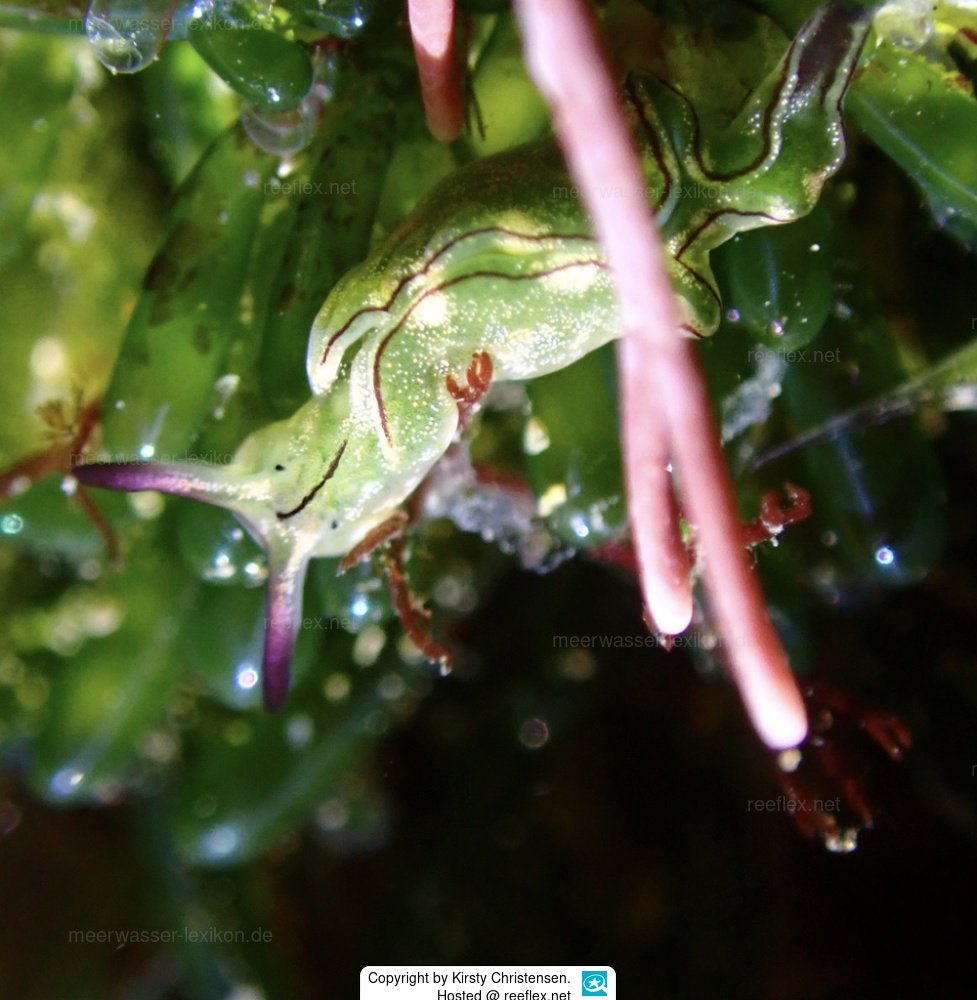Info
Elysia coodgeensis Angas, 1864
Nudibranch of genus Elysia feed primilary by piercing and sucking algae cells (chloroplasts).They are sap Sucking Slugs.Thats why Elysia is,like their food, often green.Young species are brownish or beige in colour.
Members of the genus Elysia belong to the Sacoglossa (sac-tongued slugs). The majority feed on algae. They do not eat the algae, but pierce them and suck out the chloroplasts, which are then stored in their own bodies for a period of time. The chloroplasts they ingest are called kleptochloroplasts or kleptoplastids. They are stored in the skin or other organs of the nudibranch.
With the help of the stored chloroplasts and sunlight, Elysia snails can photosynthesize and obtain energy. The chloroplasts must be renewed after a certain period of time. How long the chloroplasts can be used varies among the different Elysia species. The longest documented functional period to date is about one year.
Newly hatched and juvenile Elysia snails are often not as green in color as older specimens. The intense green color only develops with the absorption of chloroplasts. Young Elysia snails are therefore often brownish or beige. In addition, the amount of chloroplasts absorbed often determines the color intensity.
There is evidence that these snails have genetically adapted and already have their own chloroplasts in their bodies after hatching.
The green coloration then begins with the first sunbathing.
The type locality for the description of Elysia coodgeensis is New South Wales.
Description: Usually light green, short black stripe between the rhinophores, narrow black line along the edges. These sap-sucking snails grow up to 2 cm long. Elysia coodgeensis is found on green algae on sandy areas and in tidal pools up to a depth of 3 m. This species is often associated with filamentous green algae such as Enteromorpha and Chaetomorpha.
Nudibranch of genus Elysia feed primilary by piercing and sucking algae cells (chloroplasts).They are sap Sucking Slugs.Thats why Elysia is,like their food, often green.Young species are brownish or beige in colour.
Members of the genus Elysia belong to the Sacoglossa (sac-tongued slugs). The majority feed on algae. They do not eat the algae, but pierce them and suck out the chloroplasts, which are then stored in their own bodies for a period of time. The chloroplasts they ingest are called kleptochloroplasts or kleptoplastids. They are stored in the skin or other organs of the nudibranch.
With the help of the stored chloroplasts and sunlight, Elysia snails can photosynthesize and obtain energy. The chloroplasts must be renewed after a certain period of time. How long the chloroplasts can be used varies among the different Elysia species. The longest documented functional period to date is about one year.
Newly hatched and juvenile Elysia snails are often not as green in color as older specimens. The intense green color only develops with the absorption of chloroplasts. Young Elysia snails are therefore often brownish or beige. In addition, the amount of chloroplasts absorbed often determines the color intensity.
There is evidence that these snails have genetically adapted and already have their own chloroplasts in their bodies after hatching.
The green coloration then begins with the first sunbathing.
The type locality for the description of Elysia coodgeensis is New South Wales.
Description: Usually light green, short black stripe between the rhinophores, narrow black line along the edges. These sap-sucking snails grow up to 2 cm long. Elysia coodgeensis is found on green algae on sandy areas and in tidal pools up to a depth of 3 m. This species is often associated with filamentous green algae such as Enteromorpha and Chaetomorpha.







 Kirsty Christensen, Australia
Kirsty Christensen, Australia













































